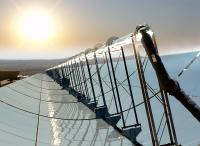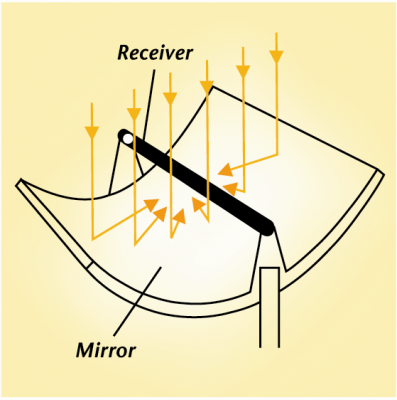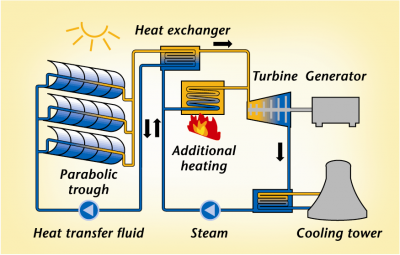 About two months ago I attended the opening of the largest “bright field” in America. While there I got the chance to meet with some representatives of SCHOTT solar the providers of the solar panels used in the field. This in turn lead to a tour of the solar cell plant. While there I started speaking with one of their representatives about solar thermal electricity.
About two months ago I attended the opening of the largest “bright field” in America. While there I got the chance to meet with some representatives of SCHOTT solar the providers of the solar panels used in the field. This in turn lead to a tour of the solar cell plant. While there I started speaking with one of their representatives about solar thermal electricity.
I got the chance to ask there CEO’s some questions about their Solar Thermal Electricity production plans. SCHOTT has been providing key components for parabolic trough collectors to collect heat and in turn produce large amounts of electricity for years now. Simple and elegant solar thermal electric generation has been an important energy production method. It will only grow in scale as people turn to renewable methods to create energy.
What follows is part three of three of the Answers they gave me. Read part one here.
8. Can solar thermal trough collection (to produce electricity) systems be adapted to home or business use?
a. If so would they be more or less efficient/cost effective than PV or wind?
At this time solar thermal parabolic trough collection is best suited for centralized large-scale power generation in sunbelt communities, and would not make economic sense for most homes or small-scale businesses.
9. Can these solar thermal trough collectors be used to provide industrial heating needs?
Yes. In fact there are industrial parabolic trough solar thermal power systems which have been in service for many years. These industrial systems have been used to heat water, provide space heating/air conditioning, process steam, and desalinate seawater.
The receiver tubes utilized in these industrial parabolic trough applications are usually smaller than the SCHOTT PTR 70 solar receiver, which is used in systems designed to produce electricity.
However, SCHOTT has provided receivers to companies developing commercial and industrial scale parabolic trough solar thermal projects.
In addition, Industrial Solar Technology Corp (www.industrialsolartech.com) uses SCHOTT glass technology to produce its industrial parabolic trough solar thermal systems.
10. Can you explain for my readers how this technology works?
a. How does it create electricity?
b. What maintenance is needed?
c. How long do the collectors last?
d. Any other information about the process you want to add?
a) Parabolic trough power plants consist of numerous trough-shaped parabolic mirrors that concentrate sunlight onto receivers (absorber tubes), such as the SCHOTT PTR 70, that are located along the focal line. Inside these specially coated receivers, concentrated solar radiation heats a special heat resistant transfer fluid to temperatures of up to 400° Celsius (752 °F).
This fluid is pumped to the central generating unit. It passes through several downstream heat exchangers and, as in conventional power plants, generates the steam that is required to drive the turbines that produce electricity. [Figure 2]
b) Certain regular maintenance is needed on the mirrors, collectors and turbines. For instance, the receivers and mirrors need to be periodically washed.
The plant’s power block (where the hot water creates steam and then drives the turbine) requires the most maintenance. However, no more maintenance is required for a solar thermal power block than is needed to the power blocks found in conventional fossil-fuel power plants.
The largest cost involved in solar thermal parabolic trough power plants is the initial capital cost to build the plant rather than operating costs – the opposite of cheap to build, expensive to operate fossil fuel power plants.
c) The collectors used at the Californian SEGS have been used for almost 20 years and are still working fine.
d) Solar thermal parabolic trough power plants have the added advantage over other forms of solar electric generation in that it is possible to generate electricity even during unfavorable weather and at night using heat storage systems.
The vast amount of heat transfer fluid circulating in the solar field already represents a considerable storage capacity which can bridge short term cloudy phases.
Molten salt storage tanks provide additional power even when the sun goes down. In Spain’s planned AndaSol power plant, a mixture of 25,000 tons of sodium and potassium nitrate will be heated to 384° C (723° F.) This should allow the power plant to operate for well over 6 hours after the sun goes down. The Spanish national carrier has given this kind of power plant system the same reliability rating as power plants using fossil fuels. The output of solar thermal power plants is thus available continuously.


http://www.oursunflowerhouse.com
looking for distributor
hello, my name is Yu Jen, after reading your topics on thermal, solar power to create electricity. I have an interesting idea to ahred with you and hope you can answer me back.
By conducting the solar power to electricity, how does it work? Do you have any graphic that can explain this technology. my other question is by using this method, will it possible for me to design a solar power-electric fan? i am very curious on this and hoped my idea will work.